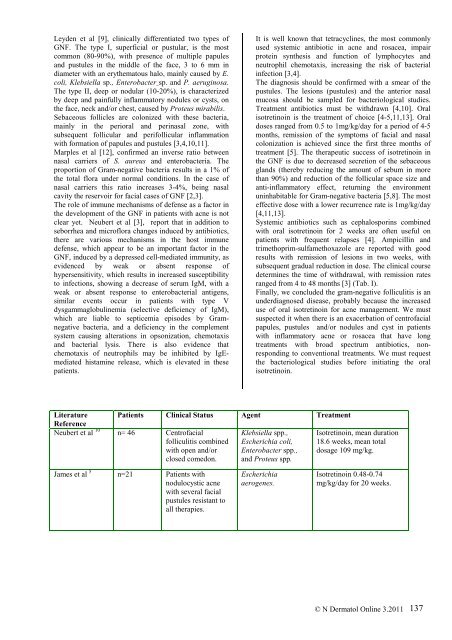Gram-negative folliculitis. a rare problem or is it - Our Dermatology ...
Gram-negative folliculitis. a rare problem or is it - Our Dermatology ...
Gram-negative folliculitis. a rare problem or is it - Our Dermatology ...
You also want an ePaper? Increase the reach of your titles
YUMPU automatically turns print PDFs into web optimized ePapers that Google loves.
Leyden et al [9], clinically differentiated two types of<br />
GNF. The type I, superficial <strong>or</strong> pustular, <strong>is</strong> the most<br />
common (80-90%), w<strong>it</strong>h presence of multiple papules<br />
and pustules in the middle of the face, 3 to 6 mm in<br />
diameter w<strong>it</strong>h an erythematous halo, mainly caused by E.<br />
coli, Klebsiella sp., Enterobacter sp. and P. aeruginosa.<br />
The type II, deep <strong>or</strong> nodular (10-20%), <strong>is</strong> characterized<br />
by deep and painfully inflammat<strong>or</strong>y nodules <strong>or</strong> cysts, on<br />
the face, neck and/<strong>or</strong> chest, caused by Proteus mirabil<strong>is</strong>.<br />
Sebaceous follicles are colonized w<strong>it</strong>h these bacteria,<br />
mainly in the peri<strong>or</strong>al and perinasal zone, w<strong>it</strong>h<br />
subsequent follicular and perifollicular inflammation<br />
w<strong>it</strong>h f<strong>or</strong>mation of papules and pustules [3,4,10,11].<br />
Marples et al [12], confirmed an inverse ratio between<br />
nasal carriers of S. aureus and enterobacteria. The<br />
prop<strong>or</strong>tion of <strong>Gram</strong>-<strong>negative</strong> bacteria results in a 1% of<br />
the total fl<strong>or</strong>a under n<strong>or</strong>mal cond<strong>it</strong>ions. In the case of<br />
nasal carriers th<strong>is</strong> ratio increases 3-4%, being nasal<br />
cav<strong>it</strong>y the reservoir f<strong>or</strong> facial cases of GNF [2,3].<br />
The role of immune mechan<strong>is</strong>ms of defense as a fact<strong>or</strong> in<br />
the development of the GNF in patients w<strong>it</strong>h acne <strong>is</strong> not<br />
clear yet. Neubert et al [3], rep<strong>or</strong>t that in add<strong>it</strong>ion to<br />
seb<strong>or</strong>rhea and microfl<strong>or</strong>a changes induced by antibiotics,<br />
there are various mechan<strong>is</strong>ms in the host immune<br />
defense, which appear to be an imp<strong>or</strong>tant fact<strong>or</strong> in the<br />
GNF, induced by a depressed cell-mediated immun<strong>it</strong>y, as<br />
evidenced by weak <strong>or</strong> absent response of<br />
hypersens<strong>it</strong>iv<strong>it</strong>y, which results in increased susceptibil<strong>it</strong>y<br />
to infections, showing a decrease of serum IgM, w<strong>it</strong>h a<br />
weak <strong>or</strong> absent response to enterobacterial antigens,<br />
similar events occur in patients w<strong>it</strong>h type V<br />
dysgammaglobulinemia (selective deficiency of IgM),<br />
which are liable to septicemia ep<strong>is</strong>odes by <strong>Gram</strong><strong>negative</strong><br />
bacteria, and a deficiency in the complement<br />
system causing alterations in opsonization, chemotax<strong>is</strong><br />
and bacterial lys<strong>is</strong>. There <strong>is</strong> also evidence that<br />
chemotax<strong>is</strong> of neutrophils may be inhib<strong>it</strong>ed by IgEmediated<br />
h<strong>is</strong>tamine release, which <strong>is</strong> elevated in these<br />
patients.<br />
It <strong>is</strong> well known that tetracyclines, the most commonly<br />
used systemic antibiotic in acne and rosacea, impair<br />
protein synthes<strong>is</strong> and function of lymphocytes and<br />
neutrophil chemotax<strong>is</strong>, increasing the r<strong>is</strong>k of bacterial<br />
infection [3,4].<br />
The diagnos<strong>is</strong> should be confirmed w<strong>it</strong>h a smear of the<br />
pustules. The lesions (pustules) and the anteri<strong>or</strong> nasal<br />
mucosa should be sampled f<strong>or</strong> bacteriological studies.<br />
Treatment antibiotics must be w<strong>it</strong>hdrawn [4,10]. Oral<br />
<strong>is</strong>otretinoin <strong>is</strong> the treatment of choice [4-5,11,13]. Oral<br />
doses ranged from 0.5 to 1mg/kg/day f<strong>or</strong> a period of 4-5<br />
months, rem<strong>is</strong>sion of the symptoms of facial and nasal<br />
colonization <strong>is</strong> achieved since the first three months of<br />
treatment [5]. The therapeutic success of <strong>is</strong>otretinoin in<br />
the GNF <strong>is</strong> due to decreased secretion of the sebaceous<br />
glands (thereby reducing the amount of sebum in m<strong>or</strong>e<br />
than 90%) and reduction of the follicular space size and<br />
anti-inflammat<strong>or</strong>y effect, returning the environment<br />
uninhab<strong>it</strong>able f<strong>or</strong> <strong>Gram</strong>-<strong>negative</strong> bacteria [5,8]. The most<br />
effective dose w<strong>it</strong>h a lower recurrence rate <strong>is</strong> 1mg/kg/day<br />
[4,11,13].<br />
Systemic antibiotics such as cephalosp<strong>or</strong>ins combined<br />
w<strong>it</strong>h <strong>or</strong>al <strong>is</strong>otretinoin f<strong>or</strong> 2 weeks are often useful on<br />
patients w<strong>it</strong>h frequent relapses [4]. Ampicillin and<br />
trimethoprim-sulfamethoxazole are rep<strong>or</strong>ted w<strong>it</strong>h good<br />
results w<strong>it</strong>h rem<strong>is</strong>sion of lesions in two weeks, w<strong>it</strong>h<br />
subsequent gradual reduction in dose. The clinical course<br />
determines the time of w<strong>it</strong>hdrawal, w<strong>it</strong>h rem<strong>is</strong>sion rates<br />
ranged from 4 to 48 months [3] (Tab. I).<br />
Finally, we concluded the gram-<strong>negative</strong> <strong>follicul<strong>it</strong><strong>is</strong></strong> <strong>is</strong> an<br />
underdiagnosed d<strong>is</strong>ease, probably because the increased<br />
use of <strong>or</strong>al <strong>is</strong>otretinoin f<strong>or</strong> acne management. We must<br />
suspected <strong>it</strong> when there <strong>is</strong> an exacerbation of centrofacial<br />
papules, pustules and/<strong>or</strong> nodules and cyst in patients<br />
w<strong>it</strong>h inflammat<strong>or</strong>y acne <strong>or</strong> rosacea that have long<br />
treatments w<strong>it</strong>h broad spectrum antibiotics, nonresponding<br />
to conventional treatments. We must request<br />
the bacteriological studies bef<strong>or</strong>e in<strong>it</strong>iating the <strong>or</strong>al<br />
<strong>is</strong>otretinoin.<br />
L<strong>it</strong>erature Patients Clinical Status Agent Treatment<br />
Reference<br />
Neubert et al 10 n= 46 Centrofacial<br />
<strong>follicul<strong>it</strong><strong>is</strong></strong> combined<br />
w<strong>it</strong>h open and/<strong>or</strong><br />
closed comedon.<br />
Klebsiella spp.,<br />
Escherichia coli,<br />
Enterobacter spp.,<br />
and Proteus spp.<br />
Isotretinoin, mean duration<br />
18.6 weeks, mean total<br />
dosage 109 mg/kg.<br />
James et al 5 n=21 Patients w<strong>it</strong>h<br />
nodulocystic acne<br />
w<strong>it</strong>h several facial<br />
pustules res<strong>is</strong>tant to<br />
all therapies.<br />
Escherichia<br />
aerogenes.<br />
Isotretinoin 0.48-0.74<br />
mg/kg/day f<strong>or</strong> 20 weeks.<br />
© N Dermatol Online 3.2011<br />
137















